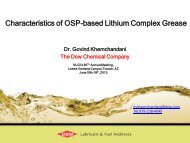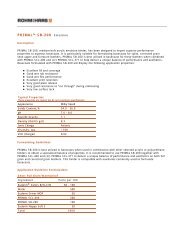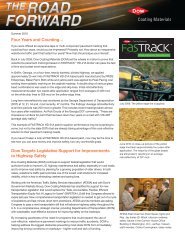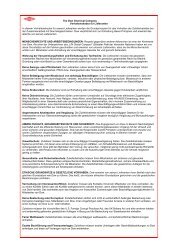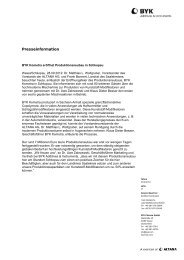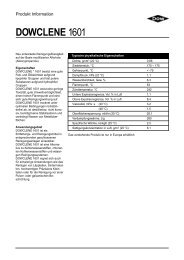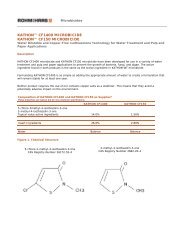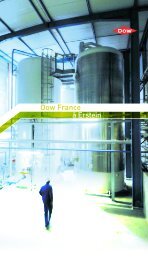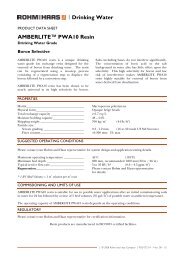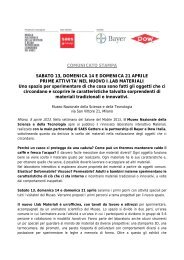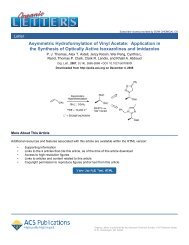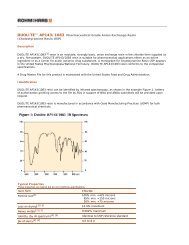CVD Zinc Sulfide - The Dow Chemical Company
CVD Zinc Sulfide - The Dow Chemical Company
CVD Zinc Sulfide - The Dow Chemical Company
Create successful ePaper yourself
Turn your PDF publications into a flip-book with our unique Google optimized e-Paper software.
over two frequency ranges: 0.1 and 10.0 GHz, and 9.0 to 18 GHz. <strong>The</strong> high frequency data is good only below 15<br />
GHz. <strong>The</strong> results (including teflon calibration) are given in Figures 12-31.<br />
References:<br />
1. R.L. Taylor, R.F. Donadio, J.A. Fuller, T.S. Taylor and G.N. Hill, “ Development of a Dual Infrared and<br />
Millimeter-Wave Aperature Antenna,” work performed under Boeing Aerospace Co., P.O. CH6411,<br />
<strong>CVD</strong> TR - 025, Oct. 1983.<br />
2. J.A. Fuller, T.S. Taylor, T.B. Elf and G.N. Hill, “Dielectric Properties of Ceramics for Millimeter-Wave Tubes,”<br />
Contract No. F33615-82-C-1718, AFWAL-TR-84-1005, Feb. 1984.<br />
3. Questions should be referred to Mr. Brian Kent, AFWAL/AAWP-3, E-O Observables Group, Phone No.<br />
(513) 255-4465/5076.<br />
<strong>The</strong> measurements included in this document were not made directly by Advanced Materials, and questions concerning experimental detail,<br />
accuracy, etc., should be addressed to the specific performing organization.<br />
Safe Handling Information<br />
<strong>CVD</strong> ZINC SELENIDE and <strong>CVD</strong> ZINC SULFIDE do not present any chemical hazard in their finished form; however,<br />
their fabrication could potentially lead to generation of hazardous materials if necessary precautions are not taken.<br />
<strong>The</strong> hazards associated with the fabrication process depend upon the specific operation; the workpiece; the<br />
abrasive system in use; and the chemical nature of any cooling and/or suspension agents added to the process<br />
water. Grinding of these materials could potentially generate zinc selenide (ZnSe), zinc sulfide (ZnS), zinc oxides<br />
(dust or fume). Loose abrasives used in the lapping and polishing of ZnSe and ZnS may contribute to airborne<br />
contamination of the work area. Wet grinding/polishing is a commonly recommended practice to minimize airborne<br />
particulates, as well as to keep the workpiece surface cool.<br />
<strong>The</strong>se materials are sensitive to high temperature. For ZnS and ZnSe, oxidation and decomposition will occur at<br />
temperature above 200°C in oxidizing atmosphere (e.g., air, oxygen, etc...) and sublimation will occur at<br />
temperature greater than about 500°C. Treatment of our lenses under elevated temperatures must be properly<br />
controlled to prevent decomposition.<br />
<strong>CVD</strong> ZINC SELENIDE and <strong>CVD</strong> ZINC SULFIDE are incompatible with strong acids and strong bases. Cleaning of<br />
these materials using incompatible solvents will result in decomposition with the release of toxic gases such as<br />
hydrogen selenide and hydrogen sulfide.<br />
Controls<br />
Ventilation: If zinc selenide or zinc sulfide are machined, ground or polished, they should be done wet to<br />
suppress dust generation. <strong>The</strong> use of water on grinding operations, however, may not eliminate the need for<br />
ventilation control as water droplets can aerosolize or evaporate, leaving respirable airborne particles. Engineering<br />
controls such as local exhaust ventilation may be necessary, depending upon the degree of airborne particles<br />
being released from the operation.<br />
Personal protective equipment: Due to the possibility of dusts and fumes being generated during the<br />
fabrication of these materials, the following personal protective equipment is recommended; depending on the<br />
degree of exposure.<br />
� <strong>Chemical</strong> goggles, splash shields, or safety glasses to protect eyes<br />
� Rubber gloves<br />
� NIOSH-approved respirator, approved for toxic dusts, mists and fumes<br />
� Eye wash and safety shower stations available in case of eye or skin contact<br />
Care must be taken to maintain all personal protective equipment in a clean and sanitary manner. Food and<br />
beverages should be kept away from areas where zinc selenide and zinc sulfide dust may be present. Hands<br />
should be thoroughly washed before eating to prevent ingestion. Broken pieces of these materials should be<br />
treated like glass, because the material is brittle and forms sharp edges when broken.



